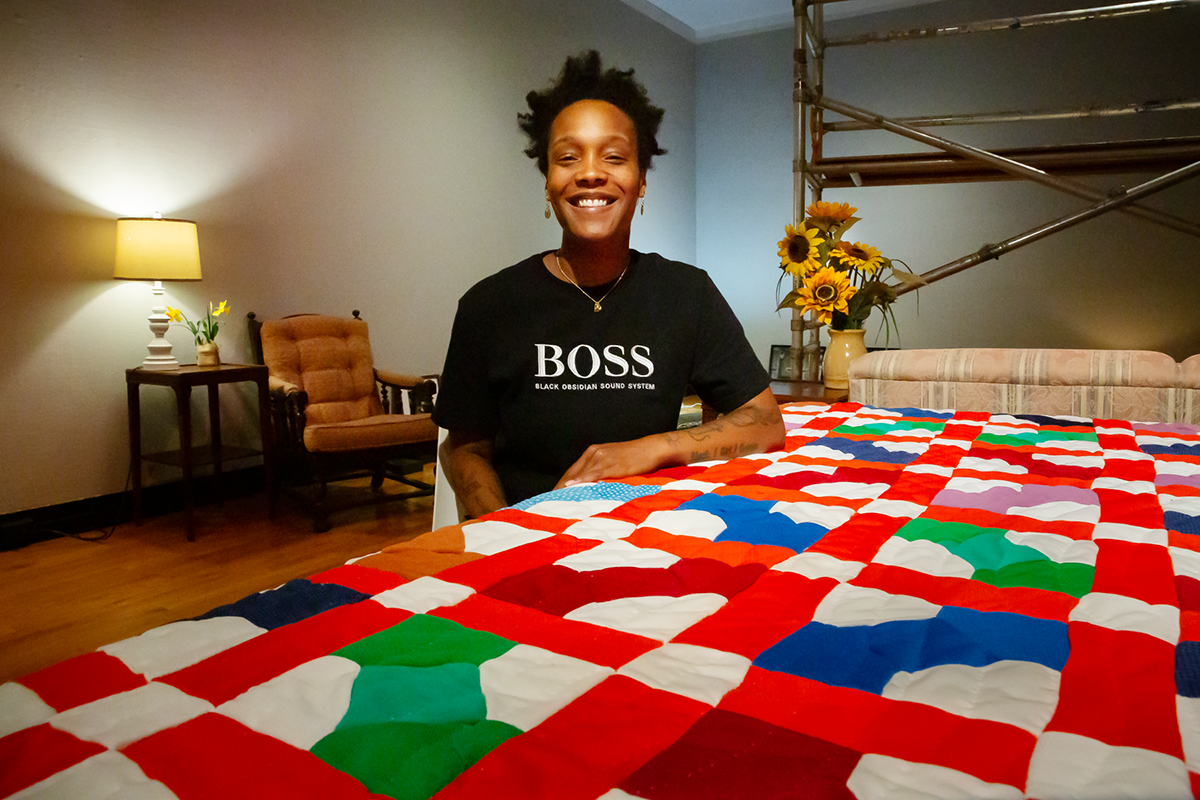
Blair Ebony Smith, a postdoctoral fellow in art education, is the curator of "Homemade, With Love: More Living Room," an exhibition at Krannert Art Museum that examines how Black girls and women can create spaces to celebrate their lives. Smith contributed to the exhibition a family quilt made in the well-known quilt-making community of Gee's Bend, Alabama.
Photo by L. Brian Stauffer
CHAMPAIGN, Ill. — A new exhibition opening at Krannert Art Museum examines what it means to create space for Black girls and women to celebrate their creative lives, while transforming a gallery into a cozy furnished "homemade" room.
"Homemade, With Love: More Living Room" is a multimedia exhibition of collage, photography, sound and interior design. It opens Aug. 27 and runs through July 3. The title is a play on the idea of a domestic physical space, but it also refers to making a space and environment for Black girls to connect and create beyond the precarious violence of anti-Black racism, said Blair Ebony Smith, the curator of "Homemade, With Love" and a postdoctoral fellow in art education at the University of Illinois, Urbana-Champaign.
Smith was inspired by Black author J. California Cooper's story collection "Homemade Love," in which Cooper describes homemaking "with care, forethought, planning and consideration for others" to create something lasting longer than we do.
"Outside of domestic spaces, home is a space we can create together," Smith said. "How can we make the museum a space for Black girls and girls of color to come in and say they can see themselves here" beyond the length of the exhibition?
Smith is bringing new ideas in public engagement research and art education to the museum at a time when institutions across the country are talking about ways in which they can become increasingly welcoming to all visitors, KAM director Jon Seydl said.
The exhibition will include multimedia collages and photographs by girls who are part of the Saving Our Lives, Hear Our Truths groups at Champaign's Franklin Middle School and Urbana Middle School. SOLHOT is a collective that celebrates Black girls and encourages them to use creative work – including photography, printmaking, dance, poetry, theater and music – to speak about the issues in their lives, said Smith, who is a member of SOLHOT.
She said she hopes to bring small groups of girls to the museum for studio art days this fall, with activities centered around the idea of being keepers of their families' histories. In the spring, they will watch films that examine how Black girls bond with nature, and they'll make artwork inspired by nature. New artwork they have created will be added to the exhibition throughout the year.
Smith said she plans to create an online archive to share the girls' artwork, writing, profiles and interviews. She's looking for projects they can do virtually, such as making music and creating a mixtape, that don't require them being together in person.
Smith furnished the exhibition gallery for "Homemade, With Love" with vintage furniture, rugs, lamps, books, and a record player and records. Unlike art exhibitions with furnishings from the collection, these groupings are meant for visitors to sit and spend time with the artwork and each other.
"She literally is turning the gallery into a domestic space, a living room, the type of environment that some folks who might not feel comfortable in a gallery environment would recognize," Seydl said. "It doesn't look like anything else we've ever done here, with the furniture, low lighting and mix of homemade and museum objects."
Smith contributed a family quilt to the exhibition. It was made in Gee's Bend, Alabama, an area famous for the quilt-making traditions of African American women, many of whom are descendants of slaves. The women make quilts known for their unique designs from scraps of cloth.
"It speaks to the tradition of being connected to artwork," Smith said. "What's really special about this exhibition is that it's personal. This is a quilt that I slept under."
Seydl saw an exhibition of Gee's Bend quilts at the Whitney Museum of American Art in New York City.
"That exhibition presented the quilts as abstract works of art, hung flat on white walls. Smith has flipped the script and presented (her quilt) over a structure meant to emulate a quilting table. As soon as I saw it, I got a sense of how someone might actually have that quilt in their house, on a bed or wrapped around you," he said.
The exhibition also will feature an installation by Jen Everett, a sculptor and visual artist based in St. Louis. "Unheard Sounds, Come Through" recalls the creative interior design traditions of Black living rooms, dens and basements, and the material objects used in those spaces – speakers, projectors, slide carousels and transistor radios.
Several KAM collection artworks created by Black women will be part of the exhibition as well, including photographs by Doris Derby, a U. of I. alumna and a documentary photographer whose work during the civil rights movement includes images of African American farming collectives and voter registration drives; photographs by Carrie Mae Weems, a visual artist known for her work on race and the African American experience; and a lithograph by renowned printmaker Margo Humphrey.






